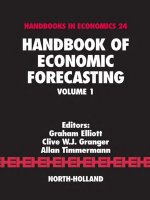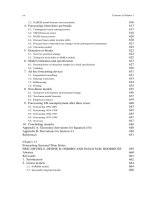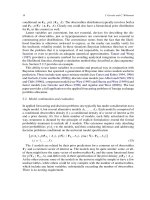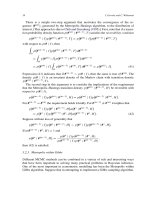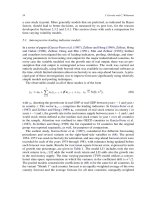Handbook of Economic Forecasting part 24 pps
Bạn đang xem bản rút gọn của tài liệu. Xem và tải ngay bản đầy đủ của tài liệu tại đây (121.57 KB, 10 trang )
204 V. Corradi and N.R. Swanson
problem, Bai (2003) uses a novel approach based on a martingalization argument to
construct a modified Kolmogorov test which has a nuisance parameter free limiting dis-
tribution. This test has power against violations of uniformity but not against violations
of independence (see below for further discussion). Hong (2001) proposes another re-
lated interesting test, based on the generalized spectrum, which has power against both
uniformity and independence violations, for the case in which the contribution of pa-
rameter estimation error vanishes asymptotically. If the null is rejected, Hong (2001)
also proposes a test for uniformity robust to non independence, which is based on the
comparison between a kernel density estimator and the uniform density. All of these
tests are discussed in detail below. In summary, two features differentiate the tests of
Corradi and Swanson (2006a, CS) from the tests outlined in the other papers mentioned
above. First, CS assume strict stationarity. Second, CS allow for dynamic misspecifica-
tion under the null hypothesis. The second feature allows CS to obtain asymptotically
valid critical values even when the conditioning information set does not contain all of
the relevant past history. More precisely, assume that we are interested in testing for
correct specification, given a particular information set which may or may not contain
all of the relevant past information. This is important when a Kolmogorov test is con-
structed, as one is generally faced with the problem of defining
t−1
. If enough history
is not included, then there may be dynamic misspecification. Additionally, finding out
how much information (e.g., how many lags) to include may involve pre-testing, hence
leading to a form of sequential test bias. By allowing for dynamic misspecification, such
pre-testing is not required.
To be more precise, critical values derived under correct specification given
t−1
are
not in general valid in the case of correct specification given a subset of
t−1
. Consider
the following example. Assume that we are interested in testing whether the conditional
distribution of y
t
|y
t−1
is N(α
†
1
y
t−1
,σ
1
). Suppose also that in actual fact the “relevant”
information set has
t−1
including both y
t−1
and y
t−2
, so that thetrueconditionalmodel
is y
t
|
t−1
= y
t
|y
t−1
,y
t−2
= N(α
1
y
t−1
+ α
2
y
t−2
,σ
2
), where α
†
1
differs from α
1
.In
this case, correct specification holds with respect to the information contained in y
t−1
;
but there is dynamic misspecification with respect to y
t−1
, y
t−2
. Even without taking
account of parameter estimation error, the critical values obtained assuming correct dy-
namic specification are invalid, thus leading to invalid inference. Stated differently, tests
that are designed to have power against both uniformity and independence violations
(i.e. tests that assume correct dynamic specification under H
0
) will reject; an inference
which is incorrect, at least in the sense that the “normality” assumption is not false.
In summary, if one is interested in the particular problem of testing for correct speci-
fication for a given information set, then the CS approach is appropriate, while if one
is instead interested in testing for correct specification assuming that
t−1
is known,
then the other tests discussed above are useful – these are some of the tests discussed in
the second part of this chapter, and all are based on probability integral transforms and
Kolmogorov–Smirnov distance measures.
In the third part of this chapter, attention is turned to the case of density model eval-
uation. Much of the development in this area stems from earlier work in the area of
Ch. 5: Predictive Density Evaluation 205
point evaluation, and hence various tests of conditional mean models for nested and
nonnested models, both under assumption of correct specification, and under the as-
sumption that all models should be viewed as “approximations”, are first discussed.
These tests include important ones by Diebold and Mariano (1995), West (1996), White
(2000), and many others. Attention is then turned to a discussion of predictive density
selection. To illustrate the sort of model evaluation tools that are discussed, consider
the following. Assume that we are given a group of (possibly) misspecified condi-
tional distributions, F
1
(u|Z
t
,θ
†
1
), . . . , F
m
(u|Z
t
,θ
†
m
), and assume that the objective is to
compare these models in terms of their “closeness” to the true conditional distribution,
F
0
(u|Z
t
,θ
0
) = Pr(Y
t+1
u|Z
t
). Corradi and Swanson (2005a, 2006b) consider such
a problem. If m>2, they follow White (2000), in the sense that a particular conditional
distribution modelis chosen as the “benchmark”and one tests the null hypothesis that no
competing model can provide a more accurate approximation of the “true” conditional
distribution against the alternative that at least one competitor outperforms the bench-
mark model. However, unlike White, they evaluate predictive densities rather than point
forecasts. Pairwise comparison of alternative models, in which no benchmark needs
to be specified, follows from their results as a special case. In their context, accuracy is
measured using a distributional analog of mean square error. More precisely, the squared
(approximation) error associated with model i, i = 1, ,m, is measured in terms of
E((F
i
(u|Z
t+1
,θ
†
i
) − F
0
(u|Z
t+1
,θ
0
))
2
), where u ∈ U, and U is a possibly unbounded
set on the real line. The case of evaluation of multiple conditional confidence interval
models is analyzed too.
Another well known measure of distributional accuracy which is also discussed in
Part III is the Kullback–Leibler Information Criterion (KLIC). The KLIC is useful be-
cause the “most accurate” model can be shown to be that which minimizes the KLIC
(see below for more details). Using the KLIC approach, Giacomini (2002) suggests a
weighted version of the Vuong (1989) likelihood ratio test for the case of dependent
observations, while Kitamura (2002) employs a KLIC based approach to select among
misspecified conditional models that satisfy given moment conditions. Furthermore,
the KLIC approach has been recently employed for the evaluation of dynamic sto-
chastic general equilibrium models [see, e.g., Schörfheide (2000), Fernandez-Villaverde
and Rubio-Ramirez (2004), and Chang, Gomes and Schorfheide (2002)]. For example,
Fernandez-Villaverde and Rubio-Ramirez (2004) show that the KLIC-best model is also
the model with the highest posterior probability. In general, there is no reason why ei-
ther of the above two measures of accuracy is more “natural”. These tests are discussed
in detail in the chapter.
As a further preamble to this chapter, we now present Table 1 which summarizes
selected testing and model evaluation papers. The list of papers in the table is undoubt-
edly incomplete, but nevertheless serves as a rough benchmark to the sorts of papers
and results that are discussed in this chapter. The primary reason for including the table
is to summarize in a directly comparable manner the assumptions made in the various
papers. Later on, assumptions are given as they appear in the original papers, and are
gathered in Appendix A.
206 V. Corradi and N.R. Swanson
Table 1
Summary of selected specification testing and model evaluation papers
Paper Eval Test Misspec Loss PEE Horizon Nesting CV
Bai (2003)
1
SCD C NAYesh = 1 NA Standard
Corradi and Swanson (2006a)
2
SCD D NAYesh = 1 NA Boot
Diebold, Gunther and Tay (1998)
2
SCD C NANoh = 1NA NA
Hong (2001) SCDC,D,GNANoh = 1 NA Standard
Hong and Li (2003)
1
SCDC,D,GNAYesh = 1 NA Standard
Chao, Corradi and Swanson (2001) SCM D DYesh 1 NA Boot
Clark and McCracken (2001, 2003) S, P CM C D Yes h 1 N,A Boot,Standard
Corradi and Swanson (2002)
3
SCM D DYesh 1 NA Boot
Corradi and Swanson (2006b) MCD G DYesh 1 O Boot
Corradi, Swanson and Olivetti (2001) PCM C DYesh 1 O Standard
Diebold, Hahn and Tay (1999) MCD C NANoh 1NA NA
Diebold and Mariano (1995) PCM G N Noh 1 O Standard
Giacomini (2002) PCD G NAYesh 1 A Standard
Giacomini and White (2003)
5
PCM G DYesh 1 A Standard
Li and Tkacz (2006) SCD C NAYesh 1 NA Standard
Rossi (2005) PCM C DYesh 1 O Standard
Thompson (2002) SCD C NAYesh 1 NA Standard
West (1996) PCM C DYesh 1 O Standard
White (2000)
4
MCM G N Yesh 1 O Boot
1
See extension in this paper to the out-of-sample case.
2
Extension to multiple horizon follows straightforwardly if the marginal distribution of the errors is normal,
for example; otherwise extension is not always straightforward.
3
This is the only predictive accuracy test from the listed papers that is consistent against generic (nonlinear)
alternatives.
4
See extension in this paper to predictive density evaluation, allowing for parameter estimation error.
5
Parameters are estimated using a fixed window of observations, so that parameters do not approach their
probability limits, but are instead treated as mixing variables under the null hypothesis.
Notes: The table provides a summary of various tests currently available. For completeness, some tests of
conditional mean are also included, particularly when they have been, or could be, extended to the case of
conditional distribution evaluation. Many tests are considered ancillary, or have been omitted due to igno-
rance. Many other tests are discussed in the papers cited in this table. “NA” entries denote “Not Applicable”.
Columns and mnemonics used are defined as follows:
• Eval = Evaluation is of: Single model (S); Pair of models (P); Multiple models (M).
• Test = Test is of: Conditional Distribution (CD); Conditional Mean (CM).
• Misspec =Misspecification assumption under H
0
: Correct specification (C); Dynamic misspecification
allowed (D); General misspecification allowed (G).
• Loss = Loss function assumption: Differentiable (D); may be non-differentiable (N).
• PEE = Parameter estimation error: accounted for (yes); not accounted for (no).
• Horizon = Prediction horizon: 1-step (h = 1); multi-step (h 1).
• Nesting = Assumption vis nestedness of models: (at least One) nonnested model required (O); Nested
models (N); Any combination (A).
• CV = Critical values constructed via: Standard limiting distribution or nuisance parameter free nonstan-
dard distribution (Standard); Bootstrap or other procedure (Boot).
Ch. 5: Predictive Density Evaluation 207
Part II: Testing for Correct Specification of Conditional Distributions
2. Specification testing and model evaluation in-sample
There are several instances in which a “good” model for the conditional mean and/or
variance is not adequate for the task at hand. For example, financial risk management
involves tracking the entire distribution of a portfolio; or measuring certain distribu-
tional aspects, such as value at risk [see, e.g., Duffie and Pan (1997)]. In these cases, the
choice of the best loss function specific model for the conditional mean may not be of
too much help. The reader is also referred to the papers by Guidolin and Timmermann
(2006, 2005) for other interesting financial applications illustrating cases where models
of conditional mean and/or variance are not adequate for the task at hand.
Important contributions that go beyond the examination of models of conditional
mean include assessing the correctness of (out-of-sample) conditional interval predic-
tion [Christoffersen (1998)] and assessing volatility predictability by comparing un-
conditional and conditional interval forecasts [Christoffersen and Diebold (2000)].
2
Needless to say, correct specification of the conditional distribution implies correct
specification of all conditional aspects of the model. Perhaps in part for this reason,
there has been growing interest in recent years in providing tests for the correct spec-
ification of conditional distributions. In this section, we analyze the issue of testing
for the correct specification of the conditional distribution, distinguishing between the
case in which we condition on the entire history and that in which we condition on a
given information set, thus allowing for dynamic misspecification. In particular, we il-
lustrate with some detail recent important work by Diebold, Gunther and Tay (1998),
based on the probability integral transformation [see also Diebold, Hahn and Tay (1999)
and Christoffersen and Diebold (2000)]; by Bai (2003), based on Kolmogorov tests and
martingalization techniques; by Hong (2001), based on the notion of generalized cross-
spectrum; and by Corradi and Swanson (2006a), based on Kolmogorov type tests. We
begin by considering the in-sample version of the tests, in which the same set of ob-
servations is used for both estimation and testing. Further, we provide an out-of-sample
version of these tests, in which the first subset of observations is used for estimation
and the last subset is used for testing. In the out-of-sample case, parameters are gen-
erally estimated using either a recursive or a rolling estimation scheme. Thus, we first
review important results by West (1996) and West and McCracken (1998) about the
limiting distribution of m-estimators and GMM estimators in a variety of contexts, such
as recursive and rolling estimation schemes.
3
As pointed in Section 3.3 below, asymp-
totic critical values for both the in-sample and out-of-sample versions of the statistic
by Corradi and Swanson can be obtained via an application of the bootstrap. While
2
Prediction confidence intervals are also discussed in Granger, White and Kamstra (1989), Diebold, Tay
and Wallis (1998), Clements and Taylor (2001), and the references cited therein. See also Zheng (2000).
3
See also Dufour, Ghysels and Hall (1994) and Ghysels and Hall (1990) for related discussion and results.
208 V. Corradi and N.R. Swanson
the asymptotic behavior of (full sample) bootstrap m-estimators is already well known,
see the literature cited below, this is no longer true for the case of bootstrap estimators
based on either a recursive or a rolling scheme. This issue is addressed by Corradi and
Swanson (2005b, 2006b) and summarized in Sections 3.4.1 and 3.4.2 below.
2.1. Diebold, Gunther and Tay approach – probability integral transform
In a key paper in the field, Diebold, Gunther and Tay (1998, DGT) use the probabil-
ity integral transform [see, e.g., Rosenblatt (1952)] to show that F
t
(y
t
|
t−1
,θ
0
) =
y
t
−∞
f
t
(y|
t−1
,θ
0
), is identically and independently distributed as a uniform random
variable on [0, 1], whenever F
t
(y
t
|
t−1
,θ
0
) is dynamically correctly specified for the
CDF of y
t
|
t−1
. Thus, they suggest to use the difference between the empirical dis-
tribution of F
t
(y
t
|
t−1
,
θ
T
) and the 45
◦
-degree line as a measure of “goodness of fit”,
where
θ
T
is some estimator of θ
0
. Visual inspection of the plot of this difference gives
also some information about the deficiency of the candidate conditional density, and so
may suggest some way of improving it. The univariate framework of DGT is extended
to a multivariate framework in Diebold, Hahn and Tay (1999, DHT), in order to allow to
evaluate the adequacy of density forecasts involving cross-variable interactions. This ap-
proach has been shown to be very useful for financial risk management [see, e.g., DGT
(1998) and DHT (1999)], as well as for macroeconomic forecasting [see Diebold, Tay
and Wallis (1998), where inflation predictions based on professional forecasts are evalu-
ated, and see Clements and Smith (2000), where predictive densities based on nonlinear
models of output and unemployment are evaluated]. Important closely related work in
the area of the evaluation of volatility forecasting and risk management is discussed
in Christoffersen and Diebold (2000). Additional tests based on the DGT idea of com-
paring the empirical distribution of F
t
(y
t
|
t−1
,
θ
T
) with the 45
◦
-degree line have been
suggested by Bai (2003), Hong (2001), Hong and Li (2003), and Corradi and Swanson
(2006a).
2.2. Bai approach – martingalization
Bai (2003) considers the following hypotheses:
(1)H
0
: Pr(y
t
y|
t−1
,θ
0
) = F
t
(y|
t−1
,θ
0
), a.s. for some θ
0
∈ ,
(2)H
A
: the negation of H
0
,
where
t−1
contains all the relevant history up to time t −1. In this sense, the null hy-
potheses corresponds with dynamic correct specification of the conditional distribution.
Bai (2003) proposes a Kolmogorov type test based on the comparison of F
t
(y|
t−1
,
θ
0
) with the CDF of a uniform random variable on [0, 1]. In practice, we need to replace
the unknown parameters, θ
0
, with an estimator, say
θ
T
. Additionally, we often do not
observe the full information set
t−1
, but only a subset of it, say Z
t
⊆
t−1
. Therefore,
we need to approximate F
t
(y|
t−1
,θ
0
) with F
t
(y|Z
t−1
,
θ
T
). Hereafter, for notational
simplicity, define
(3)
U
t
= F
t
y
t
|Z
t−1
,
θ
T
,
Ch. 5: Predictive Density Evaluation 209
(4)
U
t
= F
t
y
t
|Z
t−1
,θ
†
,
(5)U
t
= F
t
(y
t
|
t−1
,θ
0
),
where θ
†
= θ
0
whenever Z
t−1
contains all useful information in
t−1
, so that in this
case
U
t
= U
t
. As a consequence of using estimated parameters, the limiting distribution
of his test reflects the contribution of parameter estimation error and is not nuisance
parameter free. In fact, as shown in his Equations (1)–(4),
V
T
(r) =
1
√
T
T
t=1
1
U
t
r
− r
=
1
√
T
T
t=1
1
U
t
r
− r
+ g(r)
√
T
θ
T
− θ
†
+ o
P
(1)
(6)=
1
√
T
T
t=1
1{U
t
r}−r
+ g(r)
√
T
θ
T
− θ
0
+ o
P
(1),
where the last equality holds only if Z
t−1
contains all useful information in
t−1
.
4
Here,
g(r) = plim
T →∞
1
T
T
t=1
∂F
t
∂θ
x|Z
t−1
,θ
†
x=F
−1
t
(r|Z
t−1
,θ
†
)
.
Also, let
g(r) =
1,
g(r)
.
To overcome the nuisance parameter problem, Bai uses a novel approach based on a
martingalization argument to construct a modified Kolmogorov test which has a nui-
sance parameter free limiting distribution. In particular, let ˙g be the derivative of g, and
let C(r) =
1
r
˙g(τ) ˙g(τ)
dτ . Bai’s test statistic (Equation (5), p. 533) is defined as:
(7)
W
T
(r) =
V
T
(r) −
r
0
˙g(s)C
−1
(s) ˙g(s)
1
s
˙g(τ) d
V
T
(τ )
ds,
where the second term may be difficult to compute, depending on the specific ap-
plication. Several examples, including GARCH models and (self-exciting) threshold
autoregressive models are provided in Section IIIB of Bai (2003). The limiting distrib-
ution of the statistic in (7) is obtained under assumptions BAI–BAI4, which are listed
in Appendix A. It is of note that stationarity is not required. (Note also that BAI4 below
rules out non-negligible differences between the information in Z
t−1
and
t−1
, with
respect to the model of interest.).
The following result can be proven.
4
Note that
U
t
should be defined for t>s,wheres is the largest lags contained in the information set Z
t−1
,
however for notational simplicity we start all summation from t = 1, as if s = 0.
210 V. Corradi and N.R. Swanson
THEOREM 2.1 (From Corollary 1 in Bai (2003)). Let BAI1–BAI4 hold, then under H
0
,
sup
r∈[0,1]
W
T
(r)
d
→ sup
r∈[0,1]
W(r)
,
where W(r) is a standard Brownian motion. Therefore, the limiting distribution is nui-
sance parameter free and critical values can be tabulated.
Now, suppose there is dynamic misspecification, so that Pr(y
t
y|
t−1
,θ
0
) =
Pr(y
t
y|Z
t−1
,θ
†
). In this case, critical values relying on the limiting distribution
in Theorem 2.1 are no longer valid. However, if F(y
t
|Z
t−1
,θ
†
) is correctly specified
for Pr(y
t
y|Z
t−1
,θ
†
), uniformity still holds, and there is no guarantee that the sta-
tistic diverges. Thus, while Bai’s test has unit asymptotic power against violations of
uniformity, is does not have unit asymptotic power against violations of independence.
Note that in the case of dynamic misspecification, assumption BAI4 is violated. Also,
the assumption cannot be checked from the data, in general. In summary, the limiting
distribution of Kolmogorov type tests is affected by dynamic misspecification. Critical
values derived under correct dynamic specification are not in general valid in the case of
correct specification given a subset of the full information set. Consider the following
example. Assume that we are interested in testing whether the conditional distribution
of y
t
|y
t−1
is N(α
†
1
y
t−1
,σ
1
). Suppose also that in actual fact the “relevant” informa-
tion set has Z
t−1
including both y
t−1
and y
t−2
, so that the true conditional model is
y
t
|Z
t−1
= y
t
|y
t−1
,y
t−2
= N(α
1
y
t−1
+ α
2
y
t−2
,σ
2
), where α
†
1
differs from α
1
.Inthis
case, we have correct specification with respect to the information contained in y
t−1
;
but we have dynamic misspecification with respect to y
t−1
, y
t−2
. Even without tak-
ing account of parameter estimation error, the critical values obtained assuming correct
dynamic specification are invalid, thus leading to invalid inference.
2.3. Hong and Li approach – a nonparametric test
As mentioned above, the Kolmogorov test of Bai does not necessarily have power
against violations of independence. A test with power against violations of both inde-
pendence and uniformity has been recently suggested by Hong and Li (2003), who also
draw on results by Hong (2001). Their test is based on the comparison of the joint non-
parametric density of
U
t
and
U
t−j
, as defined in (3), with the product of two UN[0, 1]
random variables. In particular, they introduce a boundary modified kernel which en-
sures a “good” nonparametric estimator, even around 0 and 1. This forms the basis for
a test which has power against both non-uniformity and non-independence. For any
j>0, define
(8)
φ(u
1
,u
2
) = (n − j)
−1
n
τ =j +1
K
h
u
1
,
U
τ
K
h
u
2
,
U
τ −j
,
Ch. 5: Predictive Density Evaluation 211
where
(9)K
h
(x, y) =
⎧
⎪
⎪
⎪
⎪
⎪
⎪
⎪
⎪
⎪
⎪
⎪
⎨
⎪
⎪
⎪
⎪
⎪
⎪
⎪
⎪
⎪
⎪
⎪
⎩
h
−1
(
x−y
h
)
1
−(x/h)
k(u) du
if x ∈[0,h),
h
−1
x −y
h
if x ∈[h, 1 − h),
h
−1
(
x−y
h
)
(1−x)/h
−1
k(u) du
if x ∈[1 − h, 1].
In the above expression, h defines the bandwidth parameter, although in later sections
(where confusion cannot easily arise), h is used to denote forecast horizon. As an ex-
ample, one might use,
k(u) =
15
16
1 − u
2
2
1
|u| 1
.
Also, define
(10)
M(j) =
1
0
1
0
φ(u
1
,u
2
) − 1
2
du
1
du
2
and
(11)
Q(j) =
(n − j)
M(j) −A
0
h
V
1/2
0
,
with
A
0
h
=
h
−1
− 2
1
−1
k
2
(u) du + 2
1
0
b
−1
k
b
(u) du db
2
− 1,
k
b
(·) =
k(·)
b
−1
k(v) dv
,
and
V
0
= 2
1
−1
1
−1
k(u + v)k(v) dv
2
du
2
.
The limiting distribution of
Q(j) is obtained by Hong and Li (2003) under assumptions
HL1–HL4, which are listed in Appendix A.
5
Given this setup, the following result can be proven.
5
Hong et al. specialize their test to the case of testing continuous time models. However, as they point out,
it is equally valid for discrete time models.
212 V. Corradi and N.R. Swanson
THEOREM 2.2 (From Theorem 1 in Hong and Li (2003)). Let HL1–HL4 hold. If
h = cT
−δ
, δ ∈ (0, 1/5), then under H
0
(i.e. see (1)), for any j>0, j = o(T
1−δ(5−2/v)
),
Q(j)
d
→ N(0, 1).
Once the null is rejected, it remains of interest to know whether the rejection is due
to violation of uniformity or to violation of independence (or both). Broadly speaking,
violations of independence arises in the case of dynamic misspecification (Z
t
does not
contain enough information), while violations of uniformity arise when we misspecify
the functional form of f
t
when constructing
U
t
. Along these lines, Hong (2001) pro-
poses a test for uniformity, which is robust to dynamic misspecification. Define, the
hypotheses of interest as:
(12)H
0
: Pr
y
t
y|Z
t−1
,θ
†
= F
t
y|Z
t−1
,θ
†
, a.s. for some θ
0
∈ ,
(13)H
A
: the negation of H
0
,
where F
t
(y|Z
t−1
,θ
†
) may differ from F
t
(y|
t−1
,θ
0
). The relevant test is based on the
comparison of a kernel estimator of the marginal density of
U
t
with the uniform density,
and has a standard normal limiting distribution under the null in (12). Hong (2001) also
provides a test for the null of independence, which is robust to violations of uniformity.
Note that the limiting distribution in Theorem 2.2, as well as the limiting distrib-
ution of the uniformity (independence) test which is robust to non-uniformity (non-
independence) in Hong (2001) are all asymptotically standard normal, regardless of the
fact that we construct the statistic using
U
t
instead on U
t
. This is due to the feature that
parameter estimators converge at rate T
1/2
, while the statistics converge at nonparamet-
ric rates. The choice of the bandwidth parameter and the slower rate of convergence are
thus the prices to be paid for not having to directly account for parameter estimation
error.
2.4. Corradi and Swanson approach
Corradi and Swanson (2006a) suggest a test for the null hypothesis of correct speci-
fication of the conditional distribution, for a given information set which is, as usual,
called Z
t
, and which, as above, does not necessarily contain all relevant historical infor-
mation. The test is again a Kolmogorov type test, and is based on the fact that under the
null of correct (but not necessarily dynamically correct) specification of the conditional
distribution, U
t
is distributed as [0, 1]. As with Hong’s (2001) test, this test is thus ro-
bust to violations of independence. As will become clear below, the advantages of the
test relative to that of Hong (2001) is that it converges at a parametric rate and there
is no need to choose the bandwidth parameter. The disadvantage is that the limiting
distribution is not nuisance parameters free and hence one needs to rely on bootstrap
techniques in order to obtain valid critical values. Define:
(14)V
1T
= sup
r∈[0,1]
V
1T
(r)
,
Ch. 5: Predictive Density Evaluation 213
where
V
1T
(r) =
1
√
T
T
t=1
1
U
t
r
− r
,
and
θ
T
= arg max
θ∈
1
T
T
t=1
ln f(y
t
|X
t
,θ).
Note that the above statistic is similar to that of Bai (2003). However, there is no “extra”
term to cancel out the effect of parameter estimation error. The reason is that Bai’s
martingale transformation argument does not apply to the case in which the score is not
a martingale difference process (so that (dynamic) misspecification is not allowed for
when using his test).
The standard rationale underlying the above test, which is known to hold when
Z
t−1
=
t−1
, is that under H
0
(given above as (12)), F(y
t
|Z
t−1
,θ
0
) is distributed
independently and uniformly on [0, 1]. The uniformity result also holds under dynamic
misspecification. To see this, let c
r
f
(Z
t−1
) be the rth critical value of f(·|Z
t−1
,θ
0
),
where f is the density associated with F(·|Z
t−1
,θ
0
) (i.e. the conditional distribution
under the null).
6
It then follows that,
Pr
F
y
t
|Z
t−1
,θ
0
r
= Pr
y
t
−∞
f
y|Z
t−1
,θ
0
dy r
= Pr
1
y
t
c
r
f
Z
t−1
= 1
Z
t−1
= r, for all r ∈[0, 1],
if y
t
|Z
t−1
has density f(·|Z
t−1
,θ
0
). Now, if the density of y
t
|Z
t−1
is different from
f(·|Z
t−1
,θ
0
), then,
Pr
1
y
t
c
r
f
Z
t−1
= 1
Z
t−1
= r,
for some r with nonzero Lebesgue measure on [0, 1]. However, under dynamic mis-
specification, F(y
t
|Z
t−1
,θ
0
) is no longer independent (or even martingale difference),
in general, and this will clearly affect the covariance structure of the limiting distrib-
ution of the statistic. Theorem 2.3 below relies on Assumptions CS1–CS3, which are
listed in Appendix A.
Of note is that CS2 imposes mild smoothness and moment restrictions on the cumu-
lative distribution function under the null, and is thus easily verifiable. Also, we use
CS2(i)–(ii) in the study of the limiting behavior of V
1T
and CS2(iii)–(iv) in the study
of V
2T
.
6
For example, if f(Y|X
t
,θ
0
) ∼ N(αX
t
,σ
2
),thenc
0.95
f
(X
t
) = 1.645 + σαX
t
.

